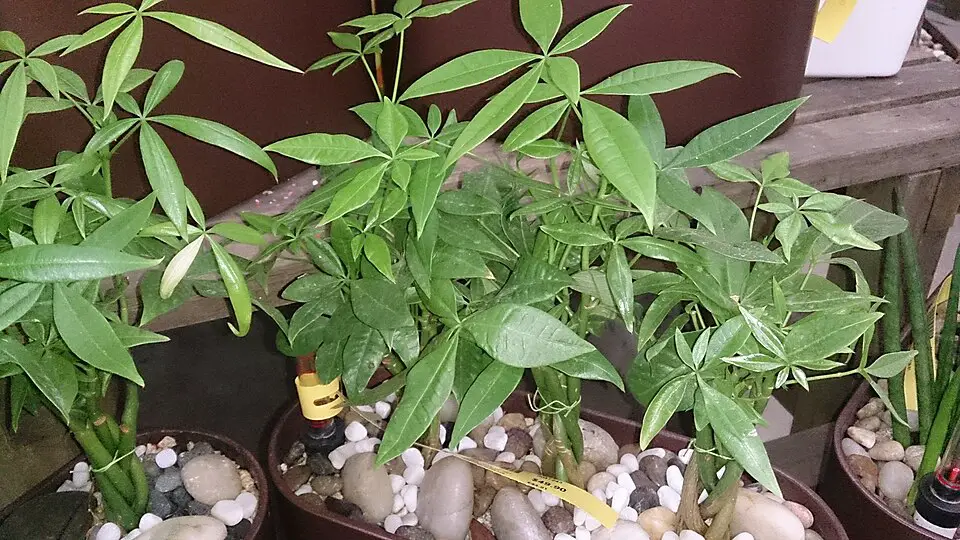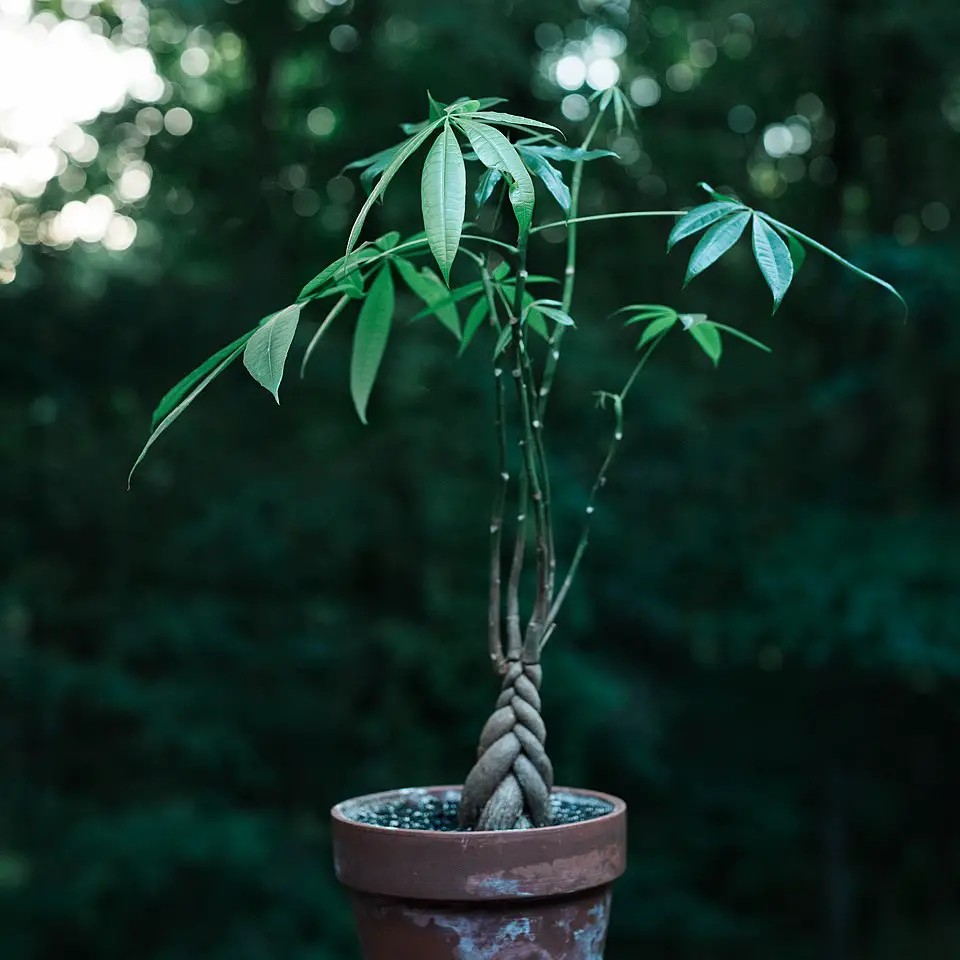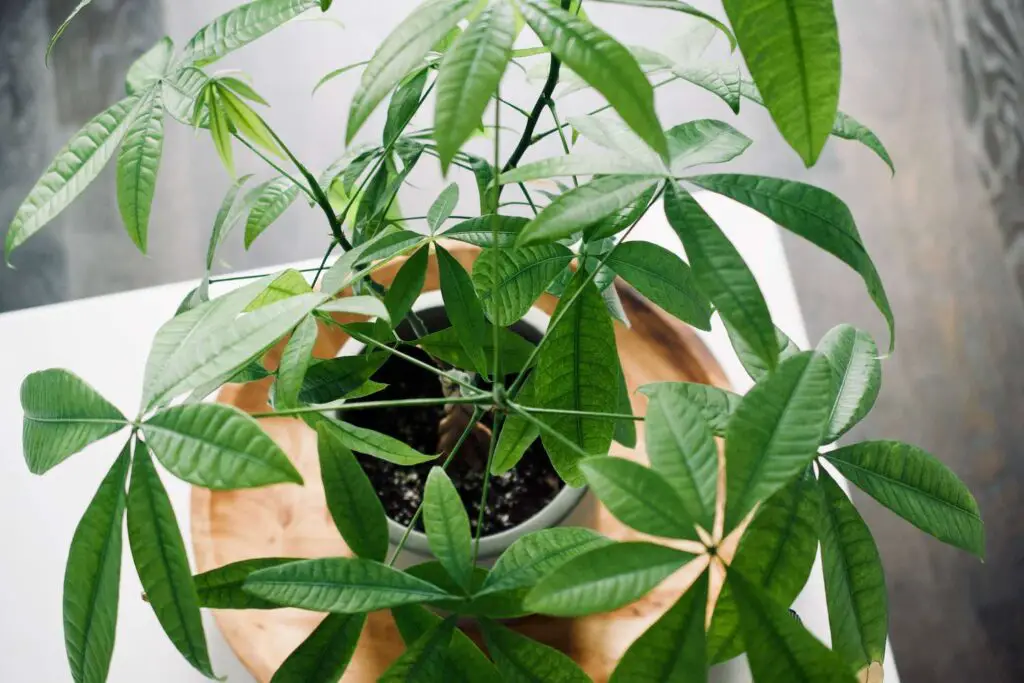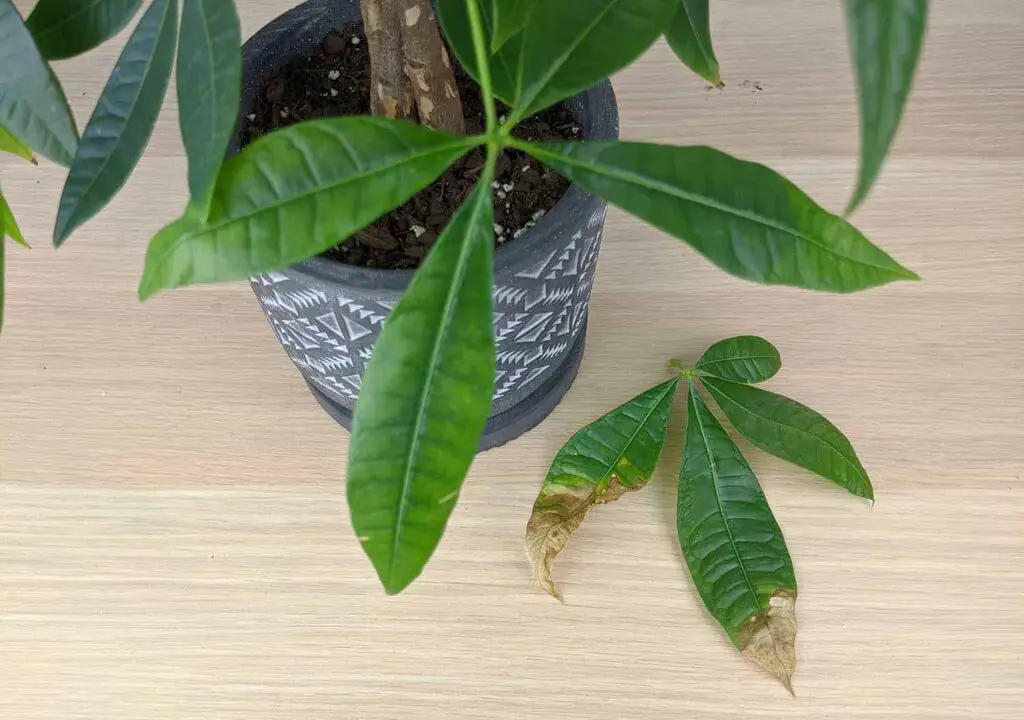The Braided Money Tree, also known as Pachira aquatica, is a stunning indoor plant characterized by its unique braided trunk and lush green leaves. It is often associated with good luck and prosperity, making it a popular choice for homes and offices.
Overview of the Braided Money Tree
The Braided Money Tree is a tropical plant native to Central and South America. It thrives in wet, marshy environments, which is why it is often found near rivers and swamps. The tree can grow quite tall in its natural habitat but is typically kept smaller indoors. This adaptability makes it an ideal houseplant for various settings.

Its braided trunk is created by intertwining the young stems of the plant as they grow. This unique feature not only adds visual interest but also symbolizes the merging of different elements of life, such as health, wealth, and happiness. The leaves of the Money Tree are palmate, resembling the shape of a hand with five leaflets, which adds to its charm.
Beyond its aesthetic appeal, the Braided Money Tree is believed to bring good fortune. Many people place them in their homes or offices hoping to attract positive energy and prosperity. This belief has contributed to the plant’s popularity across various cultures.
Care Requirements
Caring for a Braided Money Tree is relatively straightforward, making it suitable for both novice and experienced plant owners. Here are some key care requirements:

- Light: The plant prefers bright, indirect sunlight. Direct sunlight can scorch its leaves.
- Water: Allow the top inch of soil to dry out before watering again. Overwatering can lead to root rot.
- Humidity: The Money Tree enjoys higher humidity levels. Consider misting the leaves or placing a humidifier nearby.
- Temperature: It thrives in temperatures between 60°F to 75°F (15°C to 24°C). Avoid placing it near cold drafts or heat sources.
Benefits of Having a Braided Money Tree
In addition to its pleasing appearance, there are several benefits to having a Braided Money Tree in your living space:
- Air Purification: Like many plants, the Money Tree helps improve indoor air quality by filtering toxins and releasing oxygen.
- Aesthetic Appeal: Its unique structure and vibrant green leaves make it an excellent decorative piece that can enhance any room.
- Low Maintenance: The Braided Money Tree requires minimal care compared to other houseplants, making it perfect for busy individuals.
- Symbol of Prosperity: Many people believe that having this plant in their home can attract good fortune and wealth.
Common Myths
Despite its popularity, there are several myths surrounding the Braided Money Tree. Understanding these can help you appreciate the plant more:
- Mistaking it for a bonsai: While it may resemble a bonsai tree due to its size and shape, the Money Tree grows much larger in nature.
- All varieties bring luck: Not all Pachira aquatica plants are created equal. Only the braided variety is commonly associated with luck.
- Requires constant sunlight: Many believe that the plant needs constant sunlight to thrive. However, too much direct light can harm it.
The Braided Money Tree is not just another indoor plant; it represents a blend of beauty, symbolism, and easy care. With its unique braided trunk and lush foliage, it serves as both an eye-catching decor element and a beacon of good fortune in any space.

Propagating the Braided Money Tree
Propagating a Braided Money Tree can be a rewarding experience for plant enthusiasts. It allows you to create new plants from a healthy specimen. There are a couple of methods to propagate this popular houseplant, mainly through cuttings or seeds. Below are some details on each method.
Propagation by Cuttings
One of the easiest ways to propagate a Braided Money Tree is by taking cuttings from an existing plant. Here’s how you can do it:
- Select a Healthy Stem: Choose a healthy stem that is at least six inches long and has several leaves.
- Make the Cut: Use sterile pruning shears to cut the stem just below a leaf node.
- Prepare the Cutting: Remove the lower leaves from the cutting, leaving only a few leaves at the top.
- Rooting Hormone (Optional): Dip the cut end in rooting hormone to encourage faster root development.
- Plant the Cutting: Place the cutting in a pot with well-draining soil. Water lightly and cover with a plastic bag to create humidity.
- Wait for Roots: After a few weeks, check for root development by gently tugging on the cutting. Once roots have formed, remove the bag.
This method can yield new plants in a few weeks, allowing you to expand your collection or share with friends.
Propagation by Seeds
While less common, propagating through seeds is another viable method. Here’s how to do it:

- Obtain Seeds: Purchase fresh seeds or collect them from a mature Money Tree.
- Prepare the Soil: Use a seed-starting mix that drains well. Fill small pots or seed trays with this soil.
- Sow the Seeds: Plant seeds about half an inch deep and water gently.
- Provide Warmth: Place the pots in a warm location, maintaining a temperature of around 70°F (21°C).
- Keep Moist: Ensure the soil remains moist but not soggy. Covering with plastic can help maintain humidity.
- Transplanting: Once seedlings are strong enough and have several leaves, transplant them into individual pots.
This method requires patience as it can take several weeks for seeds to germinate and grow into healthy plants.
Pests and Diseases
The Braided Money Tree is generally resilient; however, it can be susceptible to certain pests and diseases. Recognizing these issues early can help you maintain a healthy plant.
Common Pests
- Aphids: Small insects that feed on sap. They can cause stunted growth and yellowing leaves.
- Spider Mites: Tiny pests that create fine webs on the leaves. Look for speckled or discolored foliage.
- Mealybugs: White, cotton-like masses found in leaf joints. They can weaken the plant if not controlled.
Diseases to Watch For
- Root Rot: Caused by overwatering, leading to mushy roots. Make sure the pot has good drainage.
- Leaf Spot: Fungal infections that appear as dark spots on leaves. Avoid overhead watering to reduce humidity around foliage.
If you notice any of these pests or diseases, take action promptly. For pests, consider using insecticidal soap or neem oil. For diseases, ensure proper care practices to prevent recurrence.
Decorating with the Braided Money Tree
The Braided Money Tree is not only easy to care for but also versatile in home decor. Its unique appearance allows it to fit into various design themes. Here are some creative ideas for incorporating this plant into your space:
- Accent Piece: Place it in a decorative pot and use it as a focal point in your living room or entryway.
- Office Companion: Position it on your desk to enhance your workspace and bring positive energy.
- Group Plantings: Combine it with smaller plants or succulents in a larger container for an attractive arrangement.
The Braided Money Tree’s ability to thrive indoors makes it an excellent choice for adding life and character to any setting. With its rich symbolism and stunning appearance, this plant is sure to be a conversation starter wherever it is placed.
Choosing the Right Pot for Your Braided Money Tree
Choosing the right pot for your Braided Money Tree is crucial for its growth and overall health. The pot not only affects drainage but also complements your plant’s aesthetic appeal. Here are some considerations to keep in mind when selecting a pot:
Size Matters
The size of the pot plays a significant role in the plant’s development. A pot that is too small can restrict root growth, while one that is too large can lead to overwatering. Here are some guidelines:
- Pot Diameter: Choose a pot that is 1-2 inches wider than the current root ball of your Money Tree.
- Depth: Ensure the pot has enough depth to accommodate the growing roots without being excessively deep.
Drainage is Essential
Proper drainage is vital to prevent root rot. When selecting a pot, look for these features:
- Drainage Holes: Ensure the pot has multiple drainage holes at the bottom to allow excess water to escape.
- Material: Choose pots made from materials like terracotta or ceramic, which allow for better aeration compared to plastic pots.
Soil Requirements for the Braided Money Tree
The right soil mix can significantly enhance the health of your Braided Money Tree. A well-draining soil will prevent water retention, protecting the roots. Here are some recommended soil characteristics:
Soil Composition
A good soil mix for a Braided Money Tree typically includes the following components:
- Potted Plant Soil: A general-purpose potting mix provides a solid foundation for your plant.
- Perlite or Sand: Adding perlite or coarse sand improves drainage and aeration.
- Peat Moss: This helps retain moisture while still allowing excess water to drain.
A mix of 50% potting soil, 25% perlite, and 25% peat moss is often ideal for optimal growth.
Fertilizing Your Braided Money Tree
Fertilization is important for ensuring that your Braided Money Tree receives the nutrients it needs to thrive. Here’s how to properly fertilize this plant:
When to Fertilize
The best time to fertilize your Braided Money Tree is during its active growing season, which generally spans from spring to early fall. Avoid fertilizing in winter when the plant is dormant.
Types of Fertilizer
You can choose between liquid fertilizers or slow-release granules. Here are some options:
- Balanced Liquid Fertilizer: Use a balanced fertilizer with equal parts nitrogen, phosphorus, and potassium (e.g., 20-20-20) diluted to half strength every month during the growing season.
- Slow-Release Granules: These can be applied every three months, providing a steady supply of nutrients without the risk of over-fertilization.
Signs of Nutrient Deficiency
Be aware of signs that your Braided Money Tree may need more nutrients:
- Yellowing Leaves: This can indicate nitrogen deficiency.
- Pale or Stunted Growth: Lack of essential nutrients can affect overall growth.
Seasonal Care Tips
Caring for
your Braided Money Tree may vary with the seasons. Here are some seasonal care tips to consider:
Spring and Summer Care
- Increase Watering: As temperatures rise, increase watering frequency while ensuring proper drainage.
- Monitor Pests: Check regularly for pests, as they tend to thrive in warmer weather.
Fall and Winter Care
- Reduce Watering: Decrease watering frequency, as the plant’s growth slows down.
- Avoid Drafts: Keep the plant away from cold drafts or heating vents that can affect temperature stability.
By following these seasonal care tips, you can ensure that your Braided Money Tree remains healthy and vibrant throughout the year.
Additional Considerations for Your Braided Money Tree
In addition
to the care and propagation techniques discussed, there are a few more aspects to consider when caring for your Braided Money Tree. These factors can enhance the plant’s growth and overall health.
Environmental Factors
The environment in which your Braided Money Tree is placed can significantly affect its growth. Here are some environmental considerations:
- Light Conditions: As previously mentioned, the plant thrives in bright, indirect light. If you notice your plant leaning towards the light source, it may need to be rotated regularly to ensure even growth.
- Humidity Levels: If your indoor air is particularly dry, especially during winter months, consider placing a humidifier nearby or grouping plants together to create a microclimate.
- Air Circulation: Ensure that the plant has adequate airflow around it. Good air circulation helps prevent mold and pests.
Common Mistakes to Avoid
Even experienced plant owners can make mistakes. Here are some common pitfalls to avoid when caring for your Braided Money Tree:
- Overwatering: One of the most frequent issues is overwatering, which can lead to root rot. Always check the soil moisture before watering.
- Ignoring Pests: Neglecting to check for pests can lead to infestations that can harm your plant. Regular inspections are key to early detection.
- Inconsistent Care: Changes in care practices can stress the plant. Try to maintain a consistent watering and feeding schedule.
By being aware of these factors and avoiding common mistakes, you can help your Braided Money Tree thrive for years to come.
Final Thoughts
The Braided Money Tree is more than just a beautiful indoor plant; it symbolizes prosperity and good fortune. Its unique braided trunk and vibrant foliage make it an attractive addition to any home or office space. With proper care, including appropriate watering, fertilizing, and seasonal adjustments, this resilient plant can flourish in a variety of environments.
Propagating your Braided Money Tree allows you to expand your collection or share this lovely plant with friends and family. Furthermore, understanding its needs—such as light, humidity, and soil requirements—can ensure its long-term health and vitality.
Incorporating this plant into your decor not only enhances the aesthetic appeal of your space but also contributes positively to your indoor environment by purifying the air. Whether you are a seasoned plant enthusiast or a beginner, the Braided Money Tree is an excellent choice that offers beauty, symbolism, and ease of care.
As you incorporate this stunning plant into your life, remember that each plant is unique and may require slight adjustments in care based on its specific environment. Embrace the journey of nurturing your Braided Money Tree, and enjoy the tranquility and positivity it brings into your living space.
